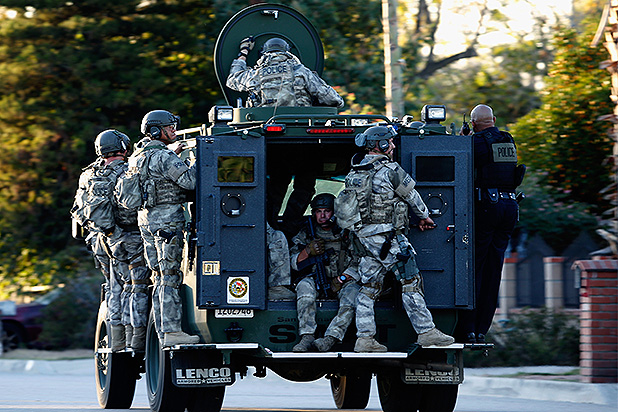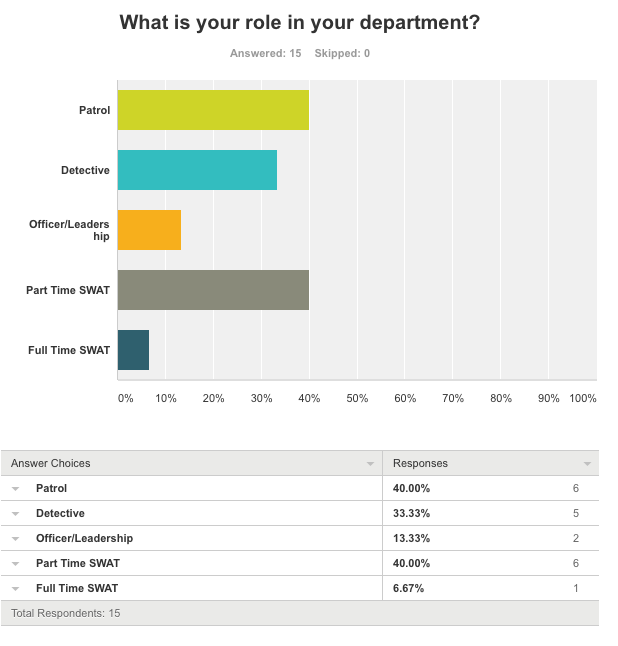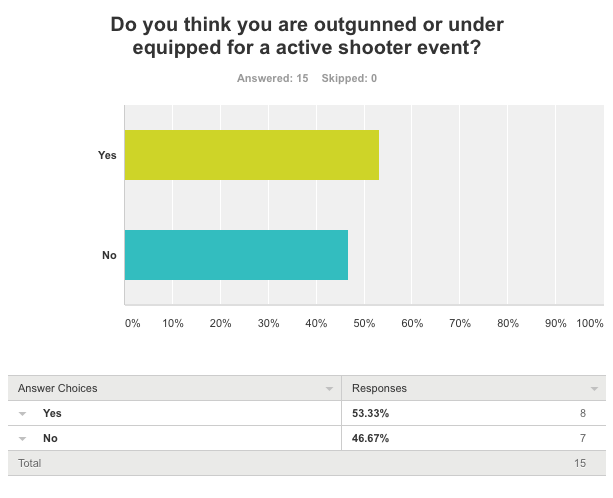
By Charles Bausman
Last week we dove in to the roles and capabilities of law enforcement response to active shooters. By profiling the attacks in San Bernardino, Orlando, Dallas, and Paris, we were able to provide a snapshot of the tactics utilized by the shooters as well as the methods of response by Police.
Click here for initial article
We wanted to determine how the Law Enforcement athletes in the MTI community feel about their equipping and training for this specific threat, and cross pollinate ideas from officers on how to learn and prepare.
Summary of Responses


Equipping and Training
Most respondents are provided a patrol rifle and additional protective equipment (hard plate body armor), although it is not common to all. Training for the patrol officer seems to be minimal, as infrequent as eight hours annually. Full time and part time SWAT teams are able to train more frequently for this specific event, but are not likely be the first on scene in the critical moments after shots have been fired.
Sharing AAR’s and Lessons Learned
No central location exists for LE departments to share after action reports or lesson learned summaries. It would seem beneficial for a national organization to establish a directory for law enforcement to post what they have learned from active shooter events and other crime related items.
Ways Forward
Respondents agree additional training and equipment is needed. Body armor, patrol rifles with optics, basic medical equipment, and breaching tools stowed in the trunk of every patrol car gives the officer a better chance of rapidly combating the active shooter. Increasing training time and frequency with force on force scenarios appears to be desired by all of those surveyed.
Additionally, active shooter community education for government employees and business owners could increase the survivability for civilians in the time before police are able to respond.
Still want to participate in the survey? Scroll to the bottom of the page and tell us what you think.
Below is the full responses from our survey. Thank you to all those who participated.
Do you believe you are well equipped and well trained for a active shooter event? Any additional equipment/training you would like to have provided?
I work for San Bernardino County Sheriff. Equipment is evolving but slow to catch up. The dept is in the process of issuing rifle plates and carriers to all 1st responders. Dept has issued more magazines but we still carry Mini-14’s with no optics. We can finally mount a light but at deputy expense. Having carried red dot equipped AR rifle platform in SWAT for about 10 years, we should at least allow Deputies to carry personal rifles if they meet standards but the dept doesn’t allow that either. It’s evolving slowly but our threats are evolving much faster.
No. Our equipment consists of our personal handgun (9mm H&K) without additional sights etc. We have a standard personal body armor (no plate carriers). We also have some sub-machineguns (MP5) but they are rare and not “easy” accessible. In my opinion the standard shooting/tactical training is by far not enough to respond appropriately in an active shooter event.
The equipment does not matter as much as the training. The ability to coordinate with your partners under the stress of a gunfight is more important than kevlar helmets or red dot sights (although ideally you would have both training and equipment). I believe I am prepared for an active shooter incident but a lot of that has to do with my own mental preparation (e.g. if/then thinking) and with practice I’ve completed on my own.
Each of our patrol vehicles is equipped with a helmet, plate carrier with extra magazine, and our officers carry M-4 carbines with iron sights and flashlight. Officers are apt to grab the rifle and go, leaving the protective equipment behind.
I personally am well equipped and trained for an active shooter event, but that’s only because I invest a lot of money in my training. I attend active shooter schools, hostage rescue training, etc. As a department, we don’t have a clue. We haven’t completed active shooter training since 2010.
Under-trained as a part-time team.
We have patrol rifles equipped with red dots and small flashlights. Additionally, the cars have go bags in them that include extra magazines. I also carry extra medical supplies and water with me.
Semi-well equipped and trained, but would like to have full on armored body armor instead of soft armor, helmet and night vision capability either on my rifle or helmet. Rifle preferred.
Well equipped, but that is a personal choice. I think Paul Howe’s course on Active Shooter was one of the best I’ve ever seen, including the ones my agency provided, as he covers plain clothes, equipment, 1-officer clears and link-ups, all critical to plain-clothes officers. I carry a specific Active Shooter bag based on his recommendations, which has already proved useful in other events as well.
How much training time are you provided specifically for active shooter scenarios?(range time, force on force scenarios, paper target scenarios)
16 to 24 hours a year block training style covering scenarios, entry, breaching and medical.
4-8 hours, depending on focus for yearly use of force training. Additional range time for long gun requalification and ‘workshops’
Our average patrol personnel train 3 times a year. SWAT trains weekly.
No range time, 8 hours general qualifications, 8 hours sim munitions training force on force per year.
Our department does a full day of force on force active shooter specific training every-other year. We are in discussions of doing this annually and adding more firearms training.
Maybe once a year, full day, active shooting training in a school is provided.
8 hours per year for specific active shooter threats (as a trainer, you have to split this off from mutli-agent building entry techniques as the techniques for single/double clear are different and will confuse if taught concurrently: essentially, the difference is slow and steady vs. rapidly and play the odds). Range time is quarterly and the range training reinforces pistol drills that cover the spectrum, as do the targets. Again, Paul Howe was instrumental in how this was set up.
What innovative ideas would enable a more rapid SWAT response time to a active shooter?
Have SWAT officers riding in vehicles with ballistic panels. Train patrol-level officers in basic SWAT tactics (CQB). SWAT officers in my opinion, will be more specialized in the near future..only used for warrant service, hostage rescue, barricaded perp situations. There’s no need to keep those tactics a secret. They will not arrive in time to “get some”. Patrol guys will be the first boots on ground.
Take home vehicles for SWAT on call teams, that would allow SWAT cops to go direct to the scene and not have to gear up at the station and then drive to the scene.
N/A. We don’t have a SWAT team available. I think smartphone based apps would improve things tremendously (ATAK in particular) married with AdHoc or other alert apps for cross-agency situational awareness.
Do you know of a central location for AAR’s or Lessons Learned from Active Shooter events?
Seven respondents answered “No”
No. I wish I did. I use Wikipedia for a lot of my research on active shooter events but it doesn’t include lessons learned.
Occasionally we get an AAR from DHS or FBI, but not for every incident.
NTOA
Is any department or agency leading in how best to respond to these new challenges?
Any agency that is teaching patrol to push the fight and get between the bad guy and the innocents is on the right track. They need to be supported with training in a variety of disciplines to be successful however.
Our county is doing very well in how we respond and train with allied agencies. I wish our equipment would evolve a little faster.
For Germany in my opinion it would be the GSG9, SEK and KSK
I believe my agency does a good job and is out in front of this issue as best we can. The biggest challenge is getting cops to think tactically when responding. Our instinct is to run to the problem an deal with it but we need to start thinking tactically–donning helmets and plates, tactical approach, communication, counter-ambush etc… We could learn a lot from guys who saw urban combat it AQ and IRQ
Los Angeles Police/Las Vegas Metro and MACTAC training.
Ottawa Police Service (Canada) equips all front line patrol cars with an IRD kit (vest, breaching tools, AR15 etc).
Clackamas County Sheriff Office
Five respondents answered “unknown”
Does your department offer active shooter “run, hide, fight” training to the community?If yes, how do you implement it?
Six respondents answered “No”
Yes – it was offered on a near weekly basis to schools / business (Amazon/Google/Microsoft) / nightclubs. It is presented by a S.W.A.T. guy using a powerpoint slide show.
We do. It is offered either in person or we offer video resources.
We have offered active shooter response to schools, but I do not believe we have done so for businesses.
Active assailant training for civilian county staff
All federal civilian employees are required to drill and train this annually. Helps to clear out the civilians quickly. We are involved in this training.
Yes, the two full time swat training coordinators teach it.
Yes, unknown how it’s implemented. It would probably be helpful to incorporate the community into the department specific active shooter training though.
How would you change training, equipment, or command structure in your department to be most prepared for an active shooter incident?
Get more breaching training and options (ballistic / explosive). Continue to teach patrol members how to respond as a single person, two person or team element. Better work to ensure communications are functional with multiple agencies responding. Do more pre-planning for high risk structures / events / locations.
More patrol sgts, and a number of officers per shift trained in containment and issued plates/helmets and additional CQC training.
All Lt’s / Capt’s / Chiefs must attend some type of commander’s course. If a national one exists (NTOA) or just local training within their department (attend a full-team training day w/ S.W.A.T.).
Our tactics and response philosophy are solid. I would just like to see us transition from mini-14’s to an AR platform with an EOTech or red dot sighting system.
1. (A lot) More shooting/tactical training for all officers who have to be out on the streets (even if the most time they will spend at their desks) 2. Plate-carriers for every officers. 3. Adequate semi-auto rifles to respond to a shooter equipped with AR/AK-like guns. 4. Medic first-responder training for police-officers. 5. Implementing the “train as you fight” mindset in tactical training
Instead of one big training session lasting all day, I would break it down to 15-20 minutes once a month on an informal basis. For example: Instead of the morning briefing, everyone practices officer rescue formations or gunshot wound treatment. The overhead for such training would be low and training would be completed with your actual partners. Which is who you would likely respond to an active shooter incident with anyway.
The actual street cops need to push up our ideas and national standards – get rid of the progressive left politicians.
More range time for the officers, allow PT while on duty, more tactical training.
Active assailant for all sworn. Active assailant command and ICS for supervisors. Standard issue patrol rifles for all sworn who can qualify. Plate carriers for patrol or rigle plate for duty vest. Optics for patrol rifles. Weapon lights for all firearms.
I would divert funding for bodycams and other useless feel good items, for plate carriers and long guns with flashlights, and red dots for every officer. More in-service training, and actually practicing CQB, with the use of FoF. More handgun and long gun qualifications. If you have budget issues, make your qual shorter. The ideal qual, is something like the Reston Group standards.
More training time for both front line officers and tactical team.
Active shooter bags, expanded training for 1-officer clear, more dynamic (shoot-house) range time, long gun for every officer, hard armor, interoperable comms.
Issued rifle plates for swat guys would be the first priority.
As mentioned earlier, bringing in the community for the training events would probably make it better. Sending more officers to SWAT type training, even if they are not going to be assigned to a team would also make responses better.
Additional comments?
Active shooter incidents can be devastating… but the new threat is Counter Terror (San Bernadino / Charlie Hebdo / Mumbai / Boston Marathon) — the extended & coordinated attack by multiple bad guys. When that happens – patrol is DEFINITELY under-trained & under-equipped. That will be the true test of that department.
Concerning my background: I’m a detective working at a state office of criminal investigation in Germany. My field of work are investigations in significant cases of islamic terrorism. My job is mainly a desk-job but from time to time we are still doing raids or other “outside” work.
A lot of people have gear for active shooter incidents (kevlar helmets, hard plated vests, long rifles, etc) but that gear is buried under other gear in a trunk or in a locker at the station. I can’t speak for everyone but if I can’t put on my gear in less than twenty seconds, I’m not going to use it during an active shooter incident. Some questions I think officers should ask themselves: How quickly can you don your gear? When was the last time you tried on your helmet? Does it even fit or is it still in the plastic wrapper that it came in? What does your First Aid kit look like? If you needed a halo dressing and trauma shears, how long would it take for you to find it? Where do you keep your tourniquet? Where does your partner keep his/hers? These are simple questions that can be answered during downtime. Reviewing where your gear is a on a regular basis will make it easier to recall under stress.
Police training is behind the curve, and needs to desperately catch up. Give officers the tools for success, by being fiscally smart and get those range trainers who don’t seek out outside training from reputable sources out of their positions. It’s no longer a sweet gig for retired on duty guys.
It’s a given the first responding officer’s need to go on the “hunt” for the shooter(s). All patrol needs training to respond in like fashion to active shooter incidents as well as hard armor because you never know what your rushing into. That would be a great start. There’s always more tools you can put in the tool box when time/budget allows.
Our agency also responded to the Boston Marathon bombing. TCCC training for every agent absolutely will save lives in a mass-casualty event.
This is a great article. Thanks for what you guys do.
Create your own user feedback survey
STAY UPDATED
Sign-up for our BETA newsletter. Training tips, research updates, videos and articles - and we’ll never sell your info.
